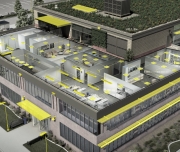Set lighting goals (e.g., for Lighting Power Density and Daylighting) early in the project and employ a 'layers of light' approach by harvesting daylight (a lighting management technique that uses daylight in place of electric light) for overhead light levels while providing occupants with additional lighting options to meet their needs.
Large windows can provide daylight to interior spaces and daylight is optimized when complementary technologies are employed, such as photosensor controls and dimming that provide a gradual transition between natural and artificial light throughout the day. Light shelves can help light penetrate deep into the interior of the space, making the best use of a window's area. Exterior shading or overhangs can let more light into the space during the winter, when heat from the sun is beneficial, and block higher-angled light in the summer, decreasing cooling loads. Window coatings also have an impact on the amount and color of light entering the space. Provide occupants seated near windows with glare control integrated into the daylighting strategy.

